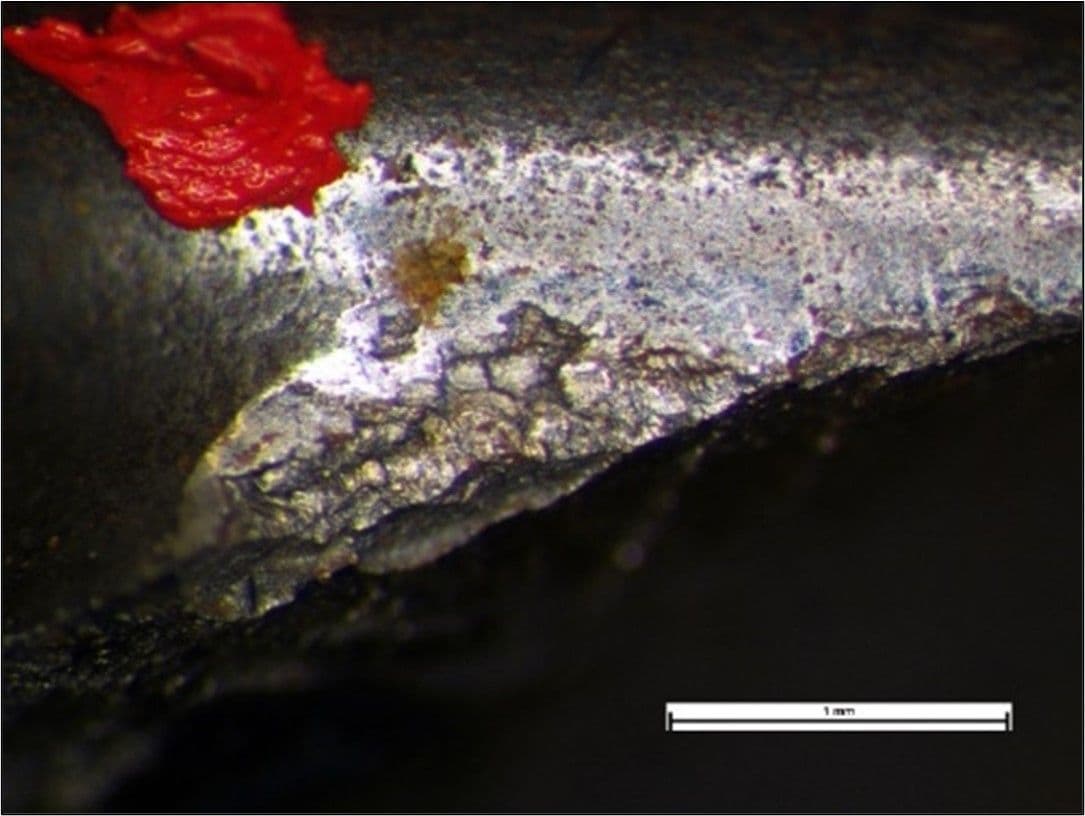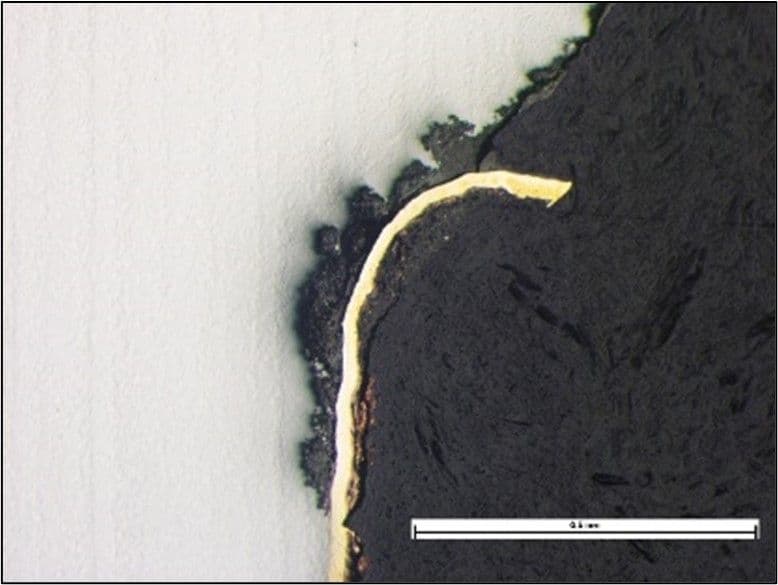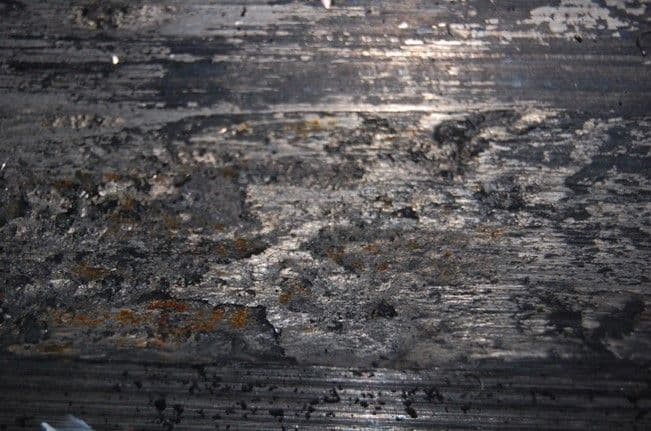
Microbial Induced Corrosion
The effect of the presence of microorganisms on the surface of a metal, resulting in the corrosion attack of the metal surface at the metal-organism interface. This typically leads to rapid pitting corrosion.
Read more>
Low Cycle Fatigue
A progressive crack growth mechanism that occurs at a relatively small number of stress cycles, but high stress, that is typically greater than the yield strength leading to plastic deformation.
Read more>
Liquid Metal Embrittlement
An unusual and uncommon failure mechanism where a liquid metal can cause the rapid attack, usually along the grain boundaries, of another metal with a higher melting point when under stress, resulting in fast brittle fracture of an otherwise ductile material. Specific metal couples exhibit such effects e.g. zinc-steel and aluminium-lead.
Read more>
Liquid Erosion/Wear
Mechanical destruction of a surface from the high energy impact of liquid droplets onto a surface. Damage can occur as a consequence of 1) the collapse of bubbles in the liquid, generating localised stress waves, termed ‘cavitation’, or 2) by stress induced in the surface from the direct impact of the liquid droplet, termed ‘liquid impingement’.
Read more>
Intergranular Corrosion
Attack of a metal along the grain boundaries often associated with localised changes in the material composition at these boundaries, due to segregation of impurities in the metal or precipitation of phases that reduce the corrosion resistance.
Read more>
Impact and Impact-Fatigue
Cracking or damage that occurs when a material is subjected to repeated impacts. High strain rates generated in the material from an impact, are greater than that experienced in ‘normal’ fatigue which can lead to rapid onset of crack initiation.
Read more>
Hydrogen Induced Cracking
A form of hydrogen embrittlement which occurs in carbon and low alloy steels when atomic hydrogen diffuses into the metal and forms molecular hydrogen. This often forms at discontinuities, such as inclusions. The molecular hydrogen internally pressurises the metal to a point where cracking occurs.
Read more>
Hydrogen Embrittlement
Hydrogen embrittlement is an umbrella term that covers several different mechanisms, but all of which involve the reduction in ductility, and subsequent fracture of metals because of atomic hydrogen and stress within the metal. It may also be associated with Stress Corrosion Cracking and Sulphide Stress Cracking.
Read more>
High Cycle Fatigue
A progressive crack growth mechanism that occurs at high cycles, and typically relatively low stress. The stress is below the yield strength of the material and any strains or deformation are in the elastic zone i.e. no permanent deformation.
Read more>
Galvanic Corrosion
Corrosion attack when two dissimilar metals are in electrical contact through an electrolyte. An electrochemical cell is set up resulting in a flow of electrons from the material with the lower electrical potential (oxidation at the anode, with corrosion/loss in material) to the material with the higher potential (reduction at the cathode).
Read more>
Fretting
Degradation of surfaces in close contact subjected to relative reciprocating movement e.g. from vibrations. Small particles of material from one or both surfaces break away and are then oxidised (corroded) which then act as an abrasive, driving damage of the surfaces.
Read more>
Erosion and Corrosion Wear
Erosion and corrosion wear refers to the combined degradation of materials due to mechanical action and chemical reactions. Erosion accelerates material loss by removing protective corrosion layers, while corrosion progressively reduces thickness through chemical attack.
Read more>
Ductile Fracture
The fracture of a material due to stress greater than the material’s ultimate tensile strength with significant plastic (permanent) deformation.
Read more>
Dealloying
Most metals used in engineering are alloys; mixtures of more than one pure metal. The corrosion process may selectively attack, and leach out one of the elements, leaving a porous and weakened structure behind. One of the most common dealloying corrosion mechanisms is the dezincification of brass, an alloy of copper and zinc.
Read more>
Crevice Corrosion
A localised form of corrosion that occurs in small gaps or crevices that create stagnation of liquids and a concentration of damaging species in the enclosed environment. Crevices may be formed under fasteners, loose coatings such as paint and insulation, bolted joints, and components in close contact.
Read more>
Creep
The time-dependent strain effect that occurs under the effects of an applied stress.
Read more>
Creep Fatigue
The combined effects of creep (a time-temperature effect) and fatigue (from cyclic stress) can be an important failure mechanism for components at high temperature. Loading, with dwell periods at high temperature can lead to creep damage, and cyclic stress can drive fatigue cracking. Cracking initiates earlier than predicted by creep or fatigue process alone
Read more>
Corrosion Fatigue
The combined action of repeating cycles of stress in a corrosive environment to produce cracking in fewer stress cycles than would otherwise occur in a non-corrosive environment.
Read more>
Buckling and Yielding
This is the failure of a component due to an applied stress that is greater than the material’s yield stress, that does not necessarily cause fracture. Buckling is a function of the geometry of the component and is often associated with thin-walled cylinders, struts, and columns.
Read more>
Brittle Fracture
The fracture of a material due to stress greater than the material’s ultimate tensile strength without any appreciable plastic deformation. The two parts of the fracture could be placed back together with the component effectively showing the same nominal geometry or dimensions.
Read more>
Adhesion Wear, Abrasion Wear, and Galling
Two surfaces in contact and relative motion will cause particles to break off due to the inherent roughness. These particles act as abrasive debris leading to further damage and accelerating the surface degradation.
Read more>
Uniform Corrosion
Uniform corrosion is a generalised form of attack that occurs relatively evenly across a large area. It is perhaps, the most common form of corrosion and occurs in many environments such as in the atmosphere, liquids, and soils. All metals are, to some degree, affected by uniform corrosion and the ‘rusting’ of steel is probably the most common example.
Read more>